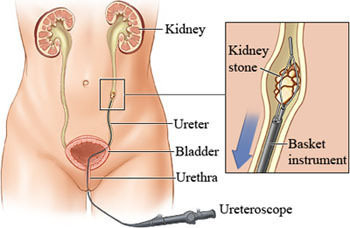Medical Expulsive Therapy (MET) should be considered in any patient with a reasonable probability for kidney stone passage. Given that stones smaller than 3 mm are already associated with an 85% chance of spontaneous passage, MET is probably most useful for stone 3-10 mm in size, though many urologists would argue for the addition of MET treatment with alpha-blockers even with smaller or proximal stones due to the relative in-expense and few side effects for patients undergoing trial of passage if it can potentially avoid need for operative intervention
Most acute stone episodes are initially treated with a period of observation as the spontaneous passage of a stone often occurs. The passage of the stone is influenced by the size and site of the stone, the smaller stones <5mm having the greatest chance of stone passage along with stones in the distal ureter as this site is closest to the bladder.
The majority of stones are expelled in 4-6 weeks but during this period the patient often experiences deterioration in the quality of life, as they’ve concerns about episodes of severe pain and admission to hospital as well as the economic implications of not being able to work.
There would, therefore, be a considerable benefit to patients and the health system if this potential time to the stone passage in suitable patients could be reduced by medical expulsive therapy which is the medication used to enhance the passage of stones or stone fragments. A similar benefit to promoting stone passage may also be present if medical expulsive therapy-MET is used following active stone treatment, SWL and ureteroscopy to remove residual fragments.
It has been shown that both alpha-blockers and calcium channel blockers may have a role in medical expulsive therapy though there are no clear guidelines on their use in initial conservative management or following definitive stone treatment.
Kidney stone treatment varies, depending on the type of stone and the cause.
During kidney stone treatment & After Medical Expulsive Therapy
Be aware of these common symptoms:
- Nausea and occasional vomiting.
- Pain in your kidneys, abdomen, lower back and sides. Pain may increase when you urinate. Take medicine as prescribed.
- Blood in your urine. The color can range from light pink to reddish and sometimes can even have a brownish hue – but you should be able to see through it. (Medications to help with a burning sensation during urination can sometimes turn urine orange or blue.) If bleeding increases significantly, call your doctor immediately or go to an emergency room for evaluation.
Be aware of these common side effects:
- Lightheadedness or dizziness
- Sinus congestion or runny nose sensation
- For men, a decrease in ejaculate volume secondary to retrograde ejaculation
Small Stones in Ureter and Kidney’s are allowed to pass out spontaneously with the newly developed medicines.
For small kidney stones do not require any type of surgery, They can be reduced by regular medication as most kidney stones won’t require invasive treatment. Usually, Kidney stone removal is facilitated by regular in taking of water and taking Medication as prescribed by kidney specialist i.e, Urologist.
Drinking water. Drinking as much as 1.9 to 2.8 litres a day may help flush out your urinary system. Unless your doctor tells you otherwise, drink enough fluid, mostly water, to produce clear or nearly clear urine.
Treatment for Bladder Stone Problems, Kidney Stone Treatment Feel Free to Schedule an Appointment with Dr.P. Vamsi Krishna


